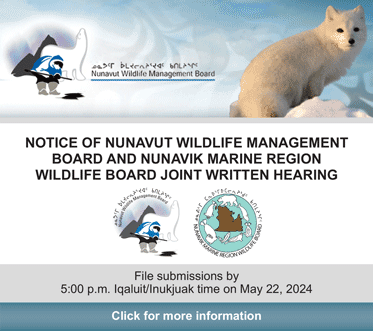'When they taste it they're pretty surprised how good it is.'
Muskox muscles out beef at barbecue competition
Chefs in Vancouver will use muskox rather than ground beef in their favourite chili recipes at the "Everything Food and Cooking Festival" barbecue competition this week.
Cambridge Bay's Kitikmeot Foods is sponsoring the barbecue to spread the news about how tasty muskox meat is.
"Nobody knows about muskox," said Smith, manager of Kitikmeot Foods.
Kitikmeot Foods plans to ship 100 pounds of ground muskox and 30 front racks of muskox for national competition as well as hundreds of smoked jerky packs for distribution at the food show.
At the food show, Smith and his employees plan to give delegates free samples of grilled muskox meat and jerky.
"When they taste it they're pretty surprised how good it is," he said.
Smith hopes the exposure results in new customers for "Tundra Brand" muskox products. Smith, who is also a journeyman meat cutter, has no trouble explaining why muskox meat should be more popular outside of Nunavut: it's completely wild, low in fat, high in protein and full of flavour.
And for those who don't eat beef or pork, muskox meat is an alternative. Huge and hairy, muskox survived the last Ice Age and are the living ancestor of today's goats and sheep.
To set the record straight about muskox, Kitikmeot Foods launched a new website, www.nunavutmuskox.ca.
These efforts are part of a major push to get more muskox meat from Cambridge Bay into the specialty meat market. This year, following a harvest of 250 muskox in March, Kitikmeot Foods has 30,000 pounds of muskox meat to sell in Canada. The largest market for muskox meat is in the western cities of Yellowknife, Edmonton, Calgary and Vancouver.
But muskox is still a tough sell.
"We haven't scratched the surface yet of the market," Smith said.
About 30,000 muskox roam near Cambridge Bay. Biologists say the 400 tags that the Ikalututiak Hunters and Trappers Organization hands out every year for the commercial and sports hunts barely touch the population's robust numbers.
However, from 2001 to 2006 there wasn't any commercial hunting after Kitikmeot Foods' abattoir failed to meet federal standards. In 2005, an unused fish plant in Cambridge Bay was transformed into a new abattoir, which now meets Canadian Food Inspection Agency standards.
This year's hunt was delayed when Nunavut's Environment Department asked the Nunavut Impact Review Board for a review of the hunt. The one-week delay meant the harvest numbers went down from 286 in 2006 to 250 this year.
The muskox hunt itself is straightforward. Hunters work in a range from about 10 to 40 kilometres from Cambridge Bay. They use .243 or larger rifles to shoot the muskox, aiming for the head or throat and avoiding young and large bulls.
Hunters then haul the muskox by snowmobile to the abattoir in komatiks. They can bring in about 30 animals a day in two batches, depending on weather and hunting success.
The hide, fur and horns go to the hunter and trapper organization.
Smith himself won't go into much detail about the muskox hunt. He's concerned that animal rights groups, who don't like the idea of any animal, wild or domesticated, being killed, may protest the muskox hunt, even though muskox aren't as cuddly as seals, weighing in between 200 and 315 kilograms.
But the commercial muskox hunt is done in a traditional way, Smith emphasizes. This means hunters find the animals and don't herd them together, as has been done in the Northwest Territories.
Kitikmeot Foods is owned by the Nunavut Development Corp. and the local HTO, who have plowed a lot of money – Smith won't say just how much – into the operation. Kitikmeot Foods returns about $100,000 back into the community in jobs.





(0) Comments